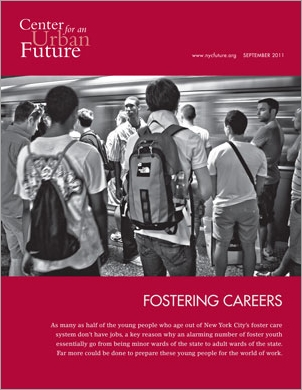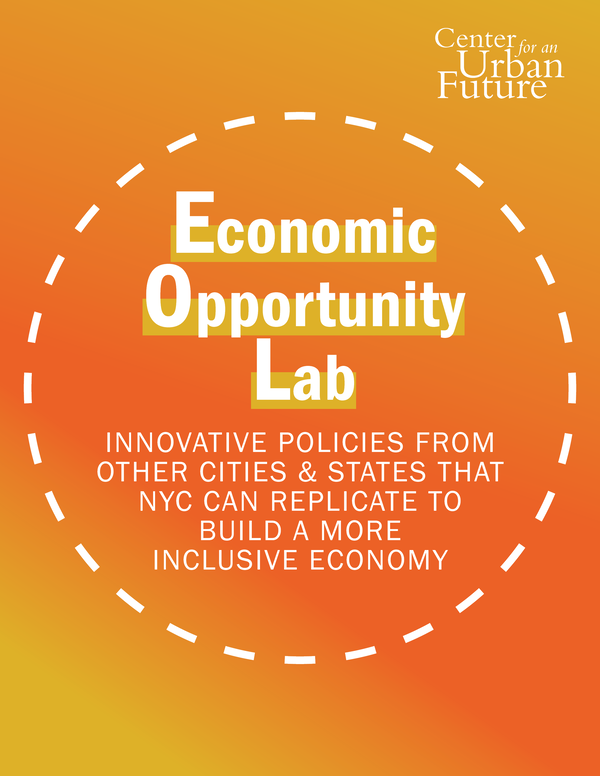While foster youth face greater hurdles than other young people in getting into the workforce, there’s little doubt that the systems responsible for foster care, youth-oriented workforce development and adult workforce development could be doing more to help foster youth access jobs.
The Administration for Children’s Services (ACS) oversees all aspects of the city’s child welfare system, from investigating reports of child abuse to ensuring the well being of young people in foster care. While ACS has improved in many aspects over the past decade, its budget for foster care programs has fallen from $903 million in 2000 to $782 million in 2010. The decline is largely attributable to a sharp drop in the overall population of those in foster care. The problem is that very little of the money saved has been invested in the young people aging out of the system. ACS also abolished the Office of Youth Development, a budget-driven move which, according to several professionals in the field, undermined the agency’s ability to focus on the needs of foster youth as a discrete population. (ACS declined to be interviewed for this report. The agency requested that we submit written questions, which we did several months ago, but responses to our questions have not been provided as of the publication date.)
To its credit, ACS has two promising initiatives underway: Building Bridges, a series of workshops coordinated by F.E.G.S., the Workforce Professionals Training Institute (WPTI), and the New York City Employment and Training Coalition (NYCETC) in partnership with ACS, that brings together the foster care and workforce development communities; and the Career & Employment Support Project, a pilot project operated by the Columbia University-based Workplace Center that seeks to build capacity to provide evidence-based career development and employment support among foster care agencies.
Foster care agencies are arguably in the best position to help strengthen the workforce readiness of their clients, and some have launched promising initiatives. But for most of these agencies, workforce development is not a strength. While each agency has a designated “Preparing Youth for Adulthood” coordinator who manages the aging out transition, the real work of preparing young people for careers must start long before foster youth are ready to leave the system—as early as age 14, if possible. Many agencies have limited connections with employers and lack specialized expertise in workforce development, making it difficult to cultivate external internships, connect foster youth to entry-level job openings, or prepare them to take the GED. “Where they might intervene on educational matters, there’s no sense of obligation to intervene in the same way for employment,” says Nanette Schrandt, director of juvenile services at the Legal Aid Society. Furthermore, caseloads are typically double the level recommended by the state Office of Children and Family Services, and caseworker turnover is high.
“Where agencies might intervene on educational matters, there’s no sense of obligation to intervene in the same way for employment”
On the workforce development side, many youth and adults get assistance from the city’s Workforce1 Career Centers. But vulnerable youth like those in foster care have a difficult time leveraging the system to prepare for and obtain jobs. “If you’re a young person aging out of foster care and you’re not work-ready, the career center is not your first stop, and it shouldn’t be your first stop.” says Francine Delgado, senior vice president for New York City programs and national technical assistance at Seedco, the nonprofit organization that manages the Manhattan and Bronx Career Workforce1 Career Centers.” The Career Centers serve the needs of employers who want work-ready employees, and they are not well-suited to prepare youth who need high-intensity services to prepare them for jobs. Instead, workforce professionals recommend that foster youth be directed to community-based organizations who can perform that preparation. These community-based organizations will typically be funded, at least in part, by the Department of Youth and Community Development (DYCD).
DYCD funds several programs to serve vulnerable youth, and these programs may in fact provide valuable educational and workforce readiness services to foster youth. However, the scale of the services they provide has declined sharply over time. According to DYCD estimates, the Out-of-School Youth program (OSY) serves a population of more than 88,000 youth who are out of school, out of work, and lacking a high school diploma or GED. But OSY is funded to serve only 1,900 teens, or about 2 percent of the youth identified by DYCD as needing assistance—and older youth between ages 22 and 24 are ineligible.
Foster youth also suffer from the antiquated standards imposed by the federal Workforce Investment Act (WIA), which funds most of DYCD’s budget. For example, OSY holds providers accountable for—and provides some of its funding on the basis of—hitting performance targets for the number of youth who get jobs, enroll in college, or obtain their GED or another credential. For some youth, these are realistic standards, and there is no question that market-recognized credentials are key to getting and keeping jobs in today’s economy. But a foster youth reading at a fourth-grade level faces major barriers to employment. That youth may need several years to reach these standards, and OSY lacks support for interim milestones along the way. OSY is a robust and valuable program, but it is also symptomatic of the difficulty DYCD faces in designing and funding programs tailored to meet the workforce needs of low-skilled foster youth.
The Summer Youth Employment Program (SYEP) is DYCD’s most high-profile program and its largest, with more than 35,000 summer internships provided in 2010. DYCD managers noticed that foster youth struggled to succeed in SYEP, and they took steps to serve foster youth by setting aside 600 “vulnerable youth” slots. These slots, available to foster youth, court-involved youth and runaway and homeless youth, provide additional supports to ensure successful completion of the internship. However, only 224 foster youth obtained vulnerable youth slots in 2010. Foster youth who belong to an agency that lacks a relationship with a vulnerable youth contractor must take their chances with the general SYEP lottery. Only 10 percent of all eligible foster youth (about 700 teens) obtained SYEP internships in 2010.
The most promising direction for strengthening the work readiness of foster youth appears to be in providing coordinated education and employment-related services that are designed with the specific needs of foster care youth in mind. One important initiative on this front is the Academy, a project conceived by five foster care agencies, funded by the Heckscher Foundation, and operated by F.E.G.S. Health and Human Services System, which provides a wide range of services to help vulnerable children, youth, adults and families. F.E.G.S. had already built a suite of education and workforce services for thousands of disconnected and at-risk youth, providing a strong base for Heckscher’s foster youth initiative.
The Academy provides a wide spectrum of education and employment services, including pre-GED and GED training, career and college exploration, sheltered internships, supported external internships, support for job interviews and job search/placement services. The structure puts a high premium on the Academy’s “no-reject/no eject” policy, which states that youth who leave can always come back. In addition, the Academy matches each youth with an adult “Youth Advisor” who will hopefully build a stable relationship with that youth. Results thus far are impressive for this population: Four out of ten obtain jobs, almost half pass the GED or increase their academic level, and most youth who enter the program stay with it and gradually improve their work readiness and education. The achievements of the Academy, along with similar programs created by the Children’s Aid Society and Fedcap, suggest that developing a separate level of workforce and educational services for foster youth may dramatically improve their life outcomes.
On the whole, we determined that the current system for strengthening work readiness among foster youth benefits from the commitment and sophistication of leaders in the foster care and youth development sectors. But the overall system is underfunded relative to the level of need, especially in services that would improve literacy and math skills among out of school youth. Further, the city should strengthen its efforts along four dimensions: coordination between the foster care, adult workforce, youth-oriented workforce and public education systems; data collection and analysis that cross system lines and extend into adulthood; work readiness services that target the neediest youth; and development of a comprehensive array of educational and workforce preferences to ensure that foster youth have access to programs from which they might otherwise be excluded.
New York City is not powerless to help foster youth. As the surrogate parent for thousands of youth, it is ultimately responsible for their well-being as adults. By coordinating the efforts of the city agencies that provide foster care, workforce development and education, and by investing in integrated work readiness and educational services to out-of-school foster youth, the city could help foster youth connect to jobs and careers. That would keep the next generation of foster youth alumni off the streets, out of prisons and welfare offices, and on the tax rolls.



